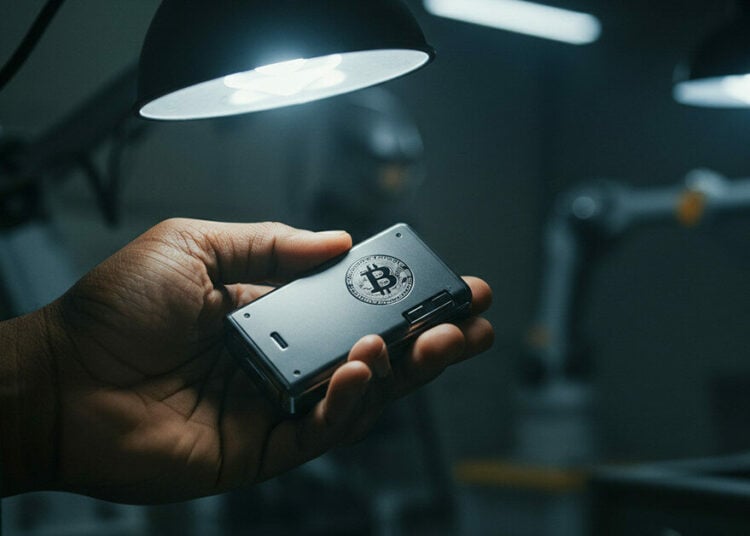When a software developer in Tallinn watched his cryptocurrency holdings vanish overnight in an exchange hack, he learned what thousands before him had discovered the hard way: not your keys, not your coins. That personal catastrophe would eventually lead to the birth of IronWallet, a crypto wallet that attempts to solve the fundamental tension between security and usability that has plagued cryptocurrency since Bitcoin’s genesis block.
The story begins with a loss, but it’s really about what happens when technologists confront the gap between cryptocurrency’s promise and its reality. The developer who lost his funds didn’t simply accept his fate. Instead, he assembled a team, each bringing complementary expertise to address what they saw as cryptocurrency’s fundamental accessibility problem.
Ermo Eero, who would become CEO, brought financial and compliance experience from traditional banking. He’d witnessed both cryptocurrency’s potential and its failures from the conventional finance side. Another co-founder, a product designer who’d spent years crafting mobile interfaces, had watched friends struggle with existing crypto wallets’ Byzantine user experiences. The original victim of the exchange hack became the security architect, channeling his loss into building what he hoped would be an impregnable fortress for digital assets.
Their shared conviction was straightforward: cryptocurrency’s complexity shouldn’t be the price of financial sovereignty. This principle would guide every decision, from interface design to security architecture.
The team’s approach to security reveals something interesting about how cryptocurrency products evolve. Initially, IronWallet began as a conventional software wallet, storing keys on users’ devices rather than company servers. This non-custodial approach was table stakes for any serious crypto wallet. But the founders recognized that simply being non-custodial wasn’t enough.
Their pivot came with the introduction of NFC-encrypted seed phrase cards. These physical cards, which users can tap against their phones to backup or restore wallets, represent an attempt to bridge the gap between hardware wallet security and software wallet convenience. The cards use 256-bit encryption, making the stored seed phrases theoretically uncrackable even if the physical card is stolen.
This hardware integration wasn’t without internal debate. Some advisors questioned whether users would bother with an additional physical component. The founders persisted, viewing it as essential to their vision of accessibility without compromise. The NFC cards eliminated one of cryptocurrency’s most dangerous failure points: users incorrectly recording their seed phrases or storing them insecurely.
The technical implementation required significant engineering effort. The team had to ensure the tap-to-backup process was both cryptographically secure and intuitive enough for non-technical users. They spent months iterating on encryption methods and testing different card materials. The result was something that looked simple but contained sophisticated security architecture underneath.
CleverPumpkin, a third-party security firm, audited the wallet in 2023, validating that seed phrases were indeed stored securely on devices rather than company servers. This external validation matters in cryptocurrency, where “trust, don’t verify” is anathema to the entire philosophical project.
Perhaps most unusually for a crypto wallet, IronWallet offers 24/7 live customer support. Not chatbots, not community forums, but actual human beings available around the clock. In an industry where tens of millions of users from MetaMask and Trust Wallet navigate largely through self-service documentation, this represents a significant operational commitment.
The economics of this decision are questionable. Maintaining round-the-clock human support for a free wallet app requires substantial ongoing investment. The founders justify it as essential to their mission of accessibility. They argue that cryptocurrency adoption stalls not because people don’t want financial sovereignty, but because the learning curve is too steep when things go wrong.
This support infrastructure reveals a philosophical stance about cryptocurrency’s future. While much of the industry embraces automation and decentralization as ends in themselves, IronWallet’s founders see these as tools that should serve human needs rather than replace human interaction entirely.
The regulatory environment presents ongoing challenges. IronWallet maintains a strict no-KYC policy, allowing users to create wallets without providing any personal information. This aligns with cryptocurrency’s privacy ethos but puts the company on potential collision course with evolving regulations.
The founders, led by Eero’s compliance expertise, have attempted to thread this needle carefully. They’ve publicly stated they’ll cooperate with legitimate law enforcement requests while preserving user privacy to the maximum extent legally permissible. This stance acknowledges regulatory reality while maintaining their core privacy commitment.
The team has monitored frameworks like the EU’s MiCA regulation, consulting legal advisors to ensure they can adapt if required. At this point they have decided to keep no-account model and stay non-custodial, supporting the moto “your keys-your coins”.
This regulatory dance illustrates a broader challenge facing privacy-focused crypto products. As governments worldwide grapple with cryptocurrency’s implications for financial surveillance and control, products that enable true financial privacy face increasing scrutiny. IronWallet’s ability to maintain its privacy stance while remaining legally compliant will likely determine its long-term viability.
The company’s governance structure reflects its philosophical commitments. Rather than a traditional hierarchy, IronWallet operates with a flat organizational structure where team members from junior support staff to senior developers can voice ideas and concerns. Weekly all-hands meetings function more like collaborative brainstorming sessions than corporate briefings.
This agile approach extends to product development. The company maintains active Telegram channels and beta testing groups where users directly interact with founders. Feature requests and bug reports from these channels often translate directly into product updates. The one-click “Scan & Send” QR code tool, now one of the wallet’s most popular features, originated from user suggestions in these early community discussions.
The founders describe this as “community-powered development,” and the evidence suggests they mean it. They’ve published blog posts explaining design decisions and admitting mistakes, an unusual level of transparency for a cryptocurrency company. This openness has cultivated a group of user-advocates who feel genuine ownership in the wallet’s evolution.
Looking at IronWallet’s path, several observations emerge. First, the project demonstrates that personal experience with cryptocurrency’s failures can drive meaningful innovation. The founder’s loss wasn’t just a cautionary tale but a catalyst for addressing systemic problems in crypto wallet design.
Second, IronWallet’s approach suggests that the binary between centralization and decentralization might be false. By maintaining non-custodial architecture while providing human support, they’ve created a hybrid model that challenges industry assumptions about what users actually want.
Third, their emphasis on privacy without complexity addresses a real market need. Many existing privacy-focused crypto tools require significant technical knowledge. IronWallet’s attempt to make privacy accessible to average users could expand the constituency for financial privacy tools.
The challenges facing IronWallet remain substantial. Scaling human support as user numbers grow will test their operational model. Maintaining privacy features as regulations tighten will require careful navigation. Competing with established wallets’ network effects and brand recognition demands continuous innovation.
Yet IronWallet’s existence itself makes an important point. In an industry often characterized by grand pronouncements about revolutionizing finance, the Ironwallet team has focused on a more modest goal: making sure people don’t lose their cryptocurrency due to poor user experience or security failures. Sometimes the most meaningful innovations come not from trying to change the world, but from preventing one person’s painful loss from happening to others.
Whether IronWallet succeeds in its mission remains uncertain. But their journey from personal catastrophe to principled product development offers lessons for anyone building in cryptocurrency. Technical innovation alone isn’t enough. Understanding and addressing human needs, even when that means maintaining costly human support infrastructure, might be what finally makes cryptocurrency accessible to mainstream users.
The wallet that emerged from loss represents something more than just another crypto product. It’s an argument that cryptocurrency’s future depends not on eliminating human interaction but on thoughtfully combining human support with cryptographic security. In an industry often obsessed with replacing trust, IronWallet suggests that earning it might be more important.





